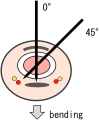A Biomechanical Study Comparing Different Configurations of the Ilizarov Mini-fixator and Plate Fixation
- PMID: 40452904
- PMCID: PMC12123430
- DOI: 10.53045/jprs.2021-0018
A Biomechanical Study Comparing Different Configurations of the Ilizarov Mini-fixator and Plate Fixation
Abstract
Objectives: The Ilizarov mini-fixator, an external fixator developed for digits, has a structure different from that of general unilateral external fixators. The purpose of this study was to provide information for clinical external fixator selection by clarifying the biomechanical properties of the Ilizarov mini-fixator.
Methods: Three types of loads were applied to the fracture fixation model using a carbon fiber cylinder as the bone model: axial pressure, 4-point bending, and torsion. Ilizarov mini-fixators with six 1.5 mm pins (6-pin group), four 1.5 mm pins (4-pin group), and four 2.0 mm-threaded-pins (2 mm-pin group) and a group using a 1.5-mm plate (plate group) were set, and the stiffness was compared between these four groups.
Results: Compared to the 6-pin group, which is the basic configuration of the Ilizarov mini-fixator, the 4-pin group had lower stiffness against axial load and bending, and there was no significant difference in stiffness against torsion. The 2 mm-pin group had high stiffness against axial load and bending and low stiffness against torsion. The plate group exhibited high stiffness against axial pressure and low stiffness against bending and torsion.
Conclusions: The Ilizarov mini-fixator is a reasonable option for fixing small phalanges. However, other options should be considered for the fixation of larger bones with higher loads. In particular, a configuration with fewer pins such as the 4-pin model may have insufficient strength during early postoperative exercise, even for fixing the phalanges.
Keywords: Ilizarov; biomechanical study; external fixator; hand surgery.
© 2022 The Japan Society of Plastic and Reconstructive Surgery.
Conflict of interest statement
Conflicts of Interest There are no conflicts of interest.
Figures








References
-
- Hernigou P. History of external fixation for treatment of fractures. Int Orthop. 2017 Apr;41(4):845-53. - PubMed
-
- Simpson AHRW, Robiati L, Jalal MMK, et al. . Non-union: indications for external fixation. Inj Int J Care Inj. 2019 Jun;50(1):73-8. - PubMed
-
- Birch JG. A brief history of limb lengthening. J Pediatr Orthop. 2017 Sep;37(2):S1-8. - PubMed
-
- Seitz WH, Gomez W, Putnam MD, et al. . Management of severe hand trauma with a mini external fixateur. Orthopedics. 1987 Apr;10(4):601-10. - PubMed
-
- Büchler U. The small AO external fixator in hand surgery. Injury. 1994;25(4):SD55-63. - PubMed
LinkOut - more resources
Full Text Sources
